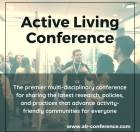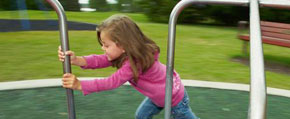We are pleased to announce an exciting new alliance between Active Living Research and GP RED to co-host and coordinate...
Does the Neighborhood Environment Influence Transportation or Recreational Physical Activity? An Analysis of Perceived and Objective Measures
Presentation at the 2004 Active Living Research Annual Conference
Background
Evidence from the fields of public health, transportation and urban planning indicates promising environmental enhancements (e.g., increases in land use mix, street connectivity, access to recreational facilities, presence of sidewalks, safety from crime and traffic, attractive features) for promoting walking and bicycling. However, few studies have simultaneously observed self-reported perceptions and unobtrusive observations of these environmental factors as well as their relative impact on transportation or recreational physical activity.
Objectives
The primary objective of the study is to determine salient features (perceived and objective) of the neighborhood environment influencing transportation and recreation activity patterns. A sub-objective is to describe the data collection methods, the corresponding measures, the process of triangulating data collected using multiple methods, and the associated analytic techniques.
Methods
Using a cross-sectional study design, investigators compared the influence of "objective" (derived by environmental audits) and "perceived" (derived by telephone survey) neighborhood characteristics on transportation and recreational physical activity. Higher and lower income study areas were selected among census tracts in St. Louis, Missouri (representing a "lowwalkable" city) and Savannah, Georgia (representing a "high-walkable" city). A targeted sample of residents from the selected census tracts was recruited for participation in the telephone survey. Neighborhood characteristics were captured using sophisticated handheld data collection devices with global positioning capabilities to link the measures with each of the street segments (i.e., the area of a roadway between two adjacent intersections) in the selected census tracts. Neighborhood characteristics fall into five primary domains: land use environment, transport environment, facilities, aesthetics, and social environment.
Results
Physical activity patterns were analyzed as continuous and dichotomous variables (meeting or not meeting public health recommendations) derived from MET-minutes/week spent on selfreported recreational and transportation activity. 1,073 individuals participated in the telephone survey (response rate = 57%) and 1,164 street segments were observed across 4.5 square miles as part of an environmental audit. Bivariate and multivariate associations were assessed between salient "objective" and "perceived" neighborhood environment variables and transportation and recreational activity. Analyses also controlled for important confounders (e.g., economic level, ethnicity).
Conclusions
This study indicates the importance of including both perceived (self-report measures) and objective (unobtrusive observations) assessments of the neighborhood environment in order to understand the factors influencing transportation and recreational physical activity. Findings also suggest that the observed assessment of the social environment is limited, and more innovative and comprehensive tools may be needed to evaluate this domain. Additional studies are needed to observe the dynamic influence of the neighborhood on physical activity behaviors over time and across community settings.
- DOWNLOAD "brennan_presentation_0.pdf" PDF (2.20 MB) Presentations
STAY UP TO DATE
RECENTLY ADDED TOOLS & RESOURCES
MOVE! A BLOG ABOUT ACTIVE LIVING
The "Active Living Conference" aims to break down research and practice silos and...







